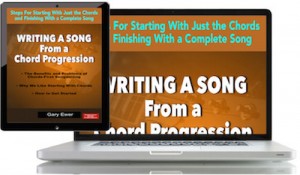What do you hate about the notion of a songwriting process? If you find that having a process stifles your creative flow, then you’re confusing the term with songwriting formula.
In songwriting, a formula means “once I’ve done this in my song, I should probably do that…”, and that can stifle your sense of creativity. But that’s not what a process is. Or at least, that’s not what it should be.
A process is simply a structure for what happens when you sit down to write. In a way, it winds up looking like a set of steps, but without the requirement that your song must be anything you don’t want it to be.
 Do you keep running into the same problems with every song you write? Here’s an eBook that can help you solve (or avoid) the 7 most common problems that practically every songwriter struggles with at some point in their writing careers: “Fix Your Songwriting Problems – NOW!”
Do you keep running into the same problems with every song you write? Here’s an eBook that can help you solve (or avoid) the 7 most common problems that practically every songwriter struggles with at some point in their writing careers: “Fix Your Songwriting Problems – NOW!”
Think of it this way: Carpenters might have a process whenever they get busy to build something. They might be building a bookcase, or it might be a back deck for their house, but no matter what it is, they’ve got their own tried & true process… their way of working. They start by sketching out the finished product, measuring it up, making a list of required materials, and then making sure they have the tools to do the job.
Some carpenters might include building a small-scale model of the finished item. That’s part of their process, no matter what the project is.
Depending on the project, their process might require them to cut the parts they need, and then assemble them. Perhaps their process is to work piece by piece, cutting as they go.
No matter what your songwriting project is, you need a process… a way of working. Why? Mainly because it prevents songs from being a random creative process where a good song might happen, and might not.
 A process provides structure to your songwriting sessions, and helps you to know what to do next.
A process provides structure to your songwriting sessions, and helps you to know what to do next.
Many songwriters have many different approaches. Some work on lyrics first, then add melody and chords.
Some work out chords, then add a melody and lyrics. Others might do chords, apply a rhythmic groove, then chant out some lyrics, find a melodic shape that works, and proceed from there.
And how do you know which process is good for you? Generally, a process is determined by what musical idea pops into your mind first. If you find that you’ve been developing lyric ideas, you’ll likely start by filling in as much of that lyric as you can, and then develop chords and melody to support that lyric. That’s your process for lyrics-first songs.
Putting a Process to Paper
 Once you’ve considered the number of ways that you typically start songs, it’s a good idea to actually write down, in a set of steps, what your process is. If you love working out lyrics as a first step, your process might be:
Once you’ve considered the number of ways that you typically start songs, it’s a good idea to actually write down, in a set of steps, what your process is. If you love working out lyrics as a first step, your process might be:
- Brainstorm song topics, and write possibilities down so that you can see them to consider them.
- Once you’ve chosen a general topic, create word lists that pertain to that topic.
- Once you’ve got a page full of words and phrases, organize those words into two lists: verse-like words (i.e., words that describe a situation or circumstance), and chorus-like words (i.e., words that describe emotions and emotional responses).
- As you work, you’ll notice (hopefully) that your song and its purpose is becoming clearer. You may find, once you get a clearer idea of what you’re writing about, that you’ll want to create new word lists, using words that more accurately pertain to your song’s topic. Keep focusing your words!
- Start putting words and phrases together to form a coherent lyric. Keep moving back and forth between verse-type words and chorus-type words.
- Think about how the lines of lyric you’re creating might cause you to imagine melodic ideas.
- Think about which chords might support those melodic ideas…
…and on it goes. That’s one possible process. The benefit of a process is that it isn’t a formula. There’s nothing about a good process that says “once you’ve used this chord, you should then use that one.”
 A process simply organizes your time, and gives you something to do. Rather than sitting, wondering what you should be doing next, you’ve got a list of steps you can follow.
A process simply organizes your time, and gives you something to do. Rather than sitting, wondering what you should be doing next, you’ve got a list of steps you can follow.
And because they’re your list of steps, you can re-order them, or change your process completely as you feel your sense of creativity dictates.
So don’t be afraid of a songwriting process. A good process will not stifle your sense of creativity. It will actually help you, discipline you, and make it much more probable that you’ll come up with something that works as a song.
To make songwriting a professional pursuit, consistency is a crucial element. And a songwriting process is a vital part of making that a reality.
 Written by Gary Ewer. Follow Gary on Twitter
Written by Gary Ewer. Follow Gary on Twitter
 Does your favourite songwriting process involve working out the chords first? There are benefits and dangers. Read “Writing a Song From a Chord Progression” to get this process working properly for you.
Does your favourite songwriting process involve working out the chords first? There are benefits and dangers. Read “Writing a Song From a Chord Progression” to get this process working properly for you.











Helpful post, thanks. I did have a lyrics-lead process based on Pat Pattison’s course but my approach has changed, being more music-lead which has some pros and cons – I find that my rhythm is more varied and interesting with the latter approach, but sometimes the storytelling falters. Breaking down the steps might be useful to refocus.
Hi Tina:
Thanks for writing. Leading with lyrics has many benefits, of course, but as you point out, any process can lead to possibly ignoring other elements. I’ve always felt that any process requires the writer to constantly “look to the side” at other elements so that they get the attention they need. Where I see the most problems is with chords-first songwriting, which often leads to uninteresting melodies. I think, as you say, coming up with some steps can allow you to refocus, and keep you attentive to all the musical details.
Thanks again Tina!
-Gary
Pingback: Talent is a Starting Point, Not a Flag to Wave | The Essential Secrets of Songwriting